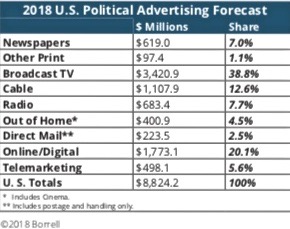Until recently political and cause advertising online was the Wild West: there were few constraints and little oversight. This year, the times are a changin’ following allegations of Russian interference in the 2016 U.S. Presidential election and the misuse of Facebook data by Cambridge Analytica.
Technology platforms and regulators are implementing a host of changes intended to deter meddling, improve transparency, and better protect personal information.

These moves do not mean that political and cause online advertising is going away: Borrell Associates forecasts that an incredible $1.77 billion will still be spent in 2018 on digital ads related to local, state, and national elections in the United States.
However, there will be significantly more restrictions and rules than in the past. Organizations that run or accept political and cause campaigns should pay close attention to these five key changes to the ways in which ads are bought, displayed, stored, and targeted.
Increased Restrictions on Who Can Buy Ads
Ad platforms are trying to deter the unlawful influencing of domestic politics by outside actors by restricting on who can by online ads.
In May, Google announced that anyone who wants to purchase an ad related to a U.S. election must provide verification/identification that proves U.S. citizenship or legal permanent resident status.
This is just the initial step for both Google and the industry. The company made it clear that it expects to expand the rule to additional countries, and other platforms such as Twitter and Facebook have implemented similar restrictions.
More Transparency on Ad Campaigns

This year, Facebook and Instagram rolled out changes that add a “paid for” tag to any political ad which runs in the US. Clicking on it leads to a page which shows who the advertiser is, how much money is being spent on the campaign, and what the audience breakdown is. Along similar lines, Twitter now requires that advertisers running political campaigns in the US have a bio with a photo, valid website, and information about who controls the handle.
Clearer Indicators of What Is Political
One if the big problems that digital ad platforms have been grappling with is that it is not always apparent when content and ads are political in nature. To address this, companies are trying to make it clear what pieces are about and who they come from. For example, Twitter has started to roll out visual indicators such as large badges and text disclaimers on tweets and ads from political campaigns.
A challenge here is that most political ads aren’t directly from, or related to, specific politicians. It’s estimated that 64% of political spend in 2018 will go to advocacy ads which are often about broad issues and/or come from third parties such as PACs.
Additional Archiving of Ads That Have Run
What’s the full range of campaigns that a political advertiser ran? What can be learned about the influence of digital units on a particular election? Until recently, these types of questions have been hard to answer because it’s been impossible to easily see all the political and cause ads paid for by someone.

New Restrictions on Data Collection and Use
Finally, there’s the biggest change to online political and cause advertising: restrictions on data collection and use. These changes could be transformative to the status quo. As POLITICO recently put it: “The data revolution in politics is about to hit serious trouble.”
For years, the ability to harvest and utilize information about individuals has enabled powerful capabilities for political advertisers, such as ads targeted to micro-audiences. With the introduction of laws such Europe’s GDPR, which created strict restrictions on data use by businesses and established clear data rights for individuals, these abilities are being significantly curtailed.
While similar laws are not yet in place in the United States, organizations that run or accept political and cause campaigns would be well-served to prepare for a day when they are put in place.
Ultimately, citizens and governments are going to continue to pay close attention to issues such as data protection and the impact of online political advertising. This means the changes and rules put in place this year may just be start of much more to come.





Join the conversation